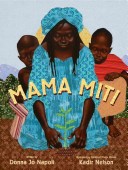
One woman. One seed. One hope for the future. Wangari grew up in the shadow of Mount Kenya listening to the stories about the people and land around her. Though the trees towered over her, she had loved them for as long as she could remember. So strong, so beautiful, how the trees made her smile. Wangari planted trees one by one to refresh her spirit. When the women came to her for help with their families, she told them to do the same. Soon the countryside was filled with trees. Kenya was strong once more. Wangari had changed her country, tree by tree. Donna Jo Napoli tells a story inspired by the life of 2004 Nobel Peace Prize recipient Wangari Maathai that will touch the hearts and spirits of all who read it. Kadir Nelson’s stunning collage illustrations honor the spirit of a land and of the woman who saved it.
- ISBN: 9781416935056
- Author: Napoli, Donna Jo
- Illustrator: Nelson, Kadir
- Published: 2010 , Simon and Schuster
- Themes: Activism, conservation, Trees, Women
- Descriptors: Africa, Biography - Autobiography- Memoir, Kenya, Picture Book, Primary (ages 6-9)
- No. of pages: 42

Wangari Muta Maathai grew up with a passion for trees and a desire to help her fellow Kenyans use their natural resources to improve their own lives. It is a great story about the importance of conservation and communities coming together to solve critical issues they face.
The illustrations in the book use fabric for all of the details, except for the women’s skin. This medium lends itself well to the natural theme in the book.
My class noticed right away that there were only women asking Miti for help and it started an interesting conversation about gender roles in our society, and in others.
Wangari Muta Maathai’s influence of the Kenyan landscape and women is celebrated in this beautifully illustrated book. The fabric and acrylic illustrations visually delight the reader as they learn about Maathai and her wise advice to African women who are seeking guidance for themselves and their children. Maathai’s simple yet powerful advice encourages self sufficiency and personal determination to change one’s situation in life. Maathai’s knowledge of botany, respect of nature, and commitment to the common good is detected in her advice of planting trees. Sadly, Wangari Maathai died in September of 2011, but her trees and mission for peace in Africa will continue to flourish and inspire.
What a wonderful book to accompany an Arbor Day or Earth Day discussion!
During a time of poverty and hardship, Wangari Maathai encourages the women of Kenya to plant trees. The trees brought food, shelter, firewood, and medicines the people of the country needed after a time of deforestation. With new flourishing trees, the country once again became green with fauna and the water in the streams started to become clear.
Wangari Maathai brought peace and life back into the country of Kenya, but not without reluctance from the Kenyan government. She was thrown in jail for promoting the coexistence of people and nature, often fighting political and economical powers that wanted more money. This period of time, known as the Green Belt Movement earned Wangari Maathai, or “Mama Miti” the Nobel Peace Prize in 2004.
The illustrations in this book are beautiful! Kadir Nelson chose to use mostly bright colored fabrics, which largely convey the African culture. The dramatic colors portray the hope the country has found from the Green Belt movement.
Wangari Maathai, the first African woman to earn a PhD (1968) and win the Noble Peace Prize, is portrayed in Mama Miti: Wangari Maathai and the Trees of Kenya. Donna Jo Napoli’s portrayal of this extraordinary woman focuses on individuals who seek her help, making the story of this modern day super hero accessible to the young reader. “Wangari took the woman’s hands and turned them over. She took the children’s hands one by one. ‘These are strong hands. Here are seedlings of the mubiru mubiru tree. Plant them. Plant as many as you can. Eat the berries.” Coupled with Kadir Nelson’s dazzling illustrations this book accentuates the essence of the remarkable founder of the “The Green Belt Movement,” a movement to plant trees in barren places across Africa, through an aesthetic invitation to celebrate the woman, the language, and culture of Africa. It inspires the reader to read and learn more about Kenya, and specifically the life of Wangari Maathai.